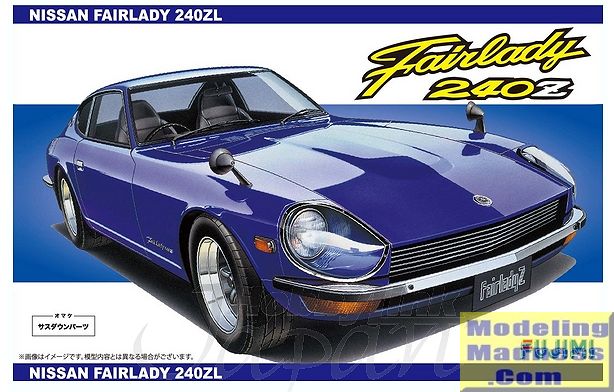
| KIT #: | 039282 |
| PRICE: | 1920 yen (about $16.00) from www.hlj.com |
| DECALS: | One option |
| REVIEWER: | Scott Van Aken |
| NOTES: |

| HISTORY |
Nissan was a relatively small automaker when it entered the international market in the 1960s and partnered with Yamaha to design a new sports car prototype to update the Nissan Fairlady. Nissan executives saw the prototype as a halo car that would improve their company's image in the minds of consumers. By 1964 Nissan realized that Yamaha's DOHC 2.0-liter engine was not meeting Nissan's expectations and the project was scrapped. Yamaha later finished a prototype and took their design to Toyota, resulting in the Toyota 2000GT.
Yutaka Katayama, the president of Nissan USA at the time, realized the importance of an affordable sports car internationally. Nissan had already produced for many decades the successful series of Fairlady roadsters that competed mainly with English and Italian roadsters, and product planners envisioned a new line of GT cars that would be stylish, innovative, fast, and relatively inexpensive through the use of interchangeable parts with other Nissan vehicles. Nissan also had the engineering background and product development experience with the recently acquired Prince Motor Company, which manufactured the Prince Skyline that was later renamed Nissan Skyline in 1966.
Sales of the Nissan Z Car started on October 1969 (for 1970 model year), with 2 separate versions: one for the Japanese market and one for the US market. The Japanese Fairlady Z featured a SOHC L20A inline-6 producing 130 PS (96 kW), while the US 240Z featured a 2.4L L24 inline-6 with twin Hitachi SU-type carburetors that produced 151 hp (113 kW) (SAE gross horsepower). A third Z, the Z432 (PS30) shared a performance version of the DOHC 2.0 L S20 engine with the Nissan Skyline 2000 GT-R.
In Japan, the Z was still known as the Fairlady to keep the car in line with the previous generation Datsun Sports roadster. JDM versions had the Fairlady Z badge on the lower fenders with the 432 badge above (the 432 designation was 4 valves, 3 carburetors, and 2 camshafts). However, Yutaka Katayama ensured the American version had all Nissan, Fairlady Z, and 432 badging replaced with "Datsun" and prevented all dealer shipments until they were replaced.
The 240Z was released in America on October 22, 1969. Combining good looks, and powerful performance, it sold over 45,000 units through the '71 model year and over 50,000 and 40,000 in 1972 and 1973, respectively.
The 260Z was released in 1974; it featured an increased engine displacement of 2.6 L and an available 2+2 model with a slightly longer wheelbase. Despite the engine size increase, power decreased to 139 hp (104 kW) (SAE net horsepower) in most areas of the US due to new camshafts, carburetors, and lower compression that were introduced to comply with new emissions regulations. In other export regions the power was increased to 154 PS (113 kW).
The 280Z was released in 1975 in North America (not to be confused with the 280ZX, which is a second-generation Z-car) and featured another engine displacement enlargement to 2.8 L. A major change was the introduction of Bosch fuel injection, replacing the previous SU carburetors. This resulted in a power increase to 170 hp (127 kW) (SAE gross horsepower), offsetting increased weight from added luxury features and an enlarged bumper that met US Federal regulations. Export markets outside North America continued to receive the Datsun 260Z until the introduction of the Datsun 280ZX at the end of 1978.
| THE KIT |
 I
am not sure if this is a reissue or not as pretty much all the explanation
stuff on the side is in Japanese and I don't see a date. The kit itself is
superbly molded with the sprues individually packaged. Despite having a
single piece body with a non-opening hood, the kit comes with a full engine
and transmission. Probably to provide something to see when looking at the
underside as the chassis is pretty open.
I
am not sure if this is a reissue or not as pretty much all the explanation
stuff on the side is in Japanese and I don't see a date. The kit itself is
superbly molded with the sprues individually packaged. Despite having a
single piece body with a non-opening hood, the kit comes with a full engine
and transmission. Probably to provide something to see when looking at the
underside as the chassis is pretty open. | CONCLUSIONS |
At one time I owned a standard 260Z and thought it was a very nice car. When I saw this one was available I knew I had to have one. When the original 240Z came out it was under $3,000, making it pretty inexpensive as GT cars go and it sold well. The Z brand has morphed into something quite different from its beginnings and this is a great kit of those beginnings.
| REFERENCES |
https://en.wikipedia.org/wiki/Nissan_Z-car
July 2015
Thanks to www.hlj.com for the preview kit. Get yours at this link.
If you would like your product reviewed fairly and fairly quickly, please contact the editor or see other details in the Note to Contributors.